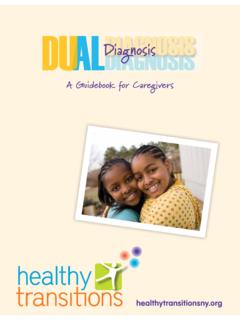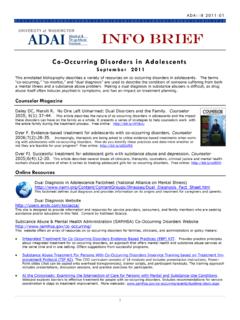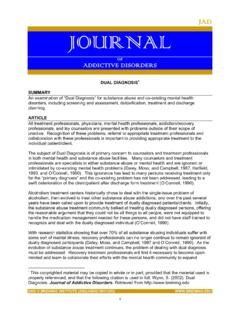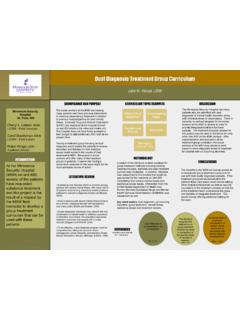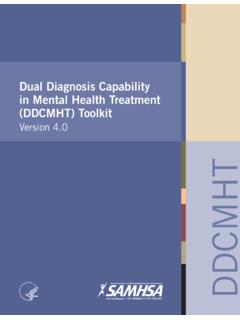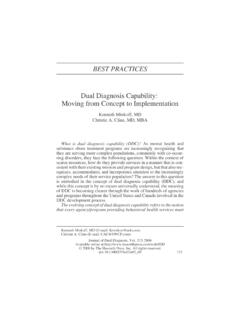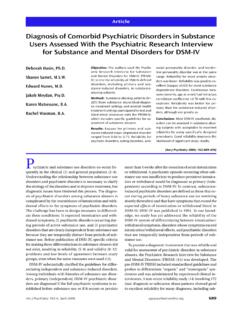Transcription of Dual Diagnosis Nursing Care: Treating thhhe Patient with ...
1 dual Diagnosis Nursing care : hhTreating the Patient withCo-Occurring Addiction & Mental Health Disorders. Deborah Koivula Overview & Objectives current trends in co-occurring disorders the most common mental health issues among addicted patients screening and assessment tools used in dual Diagnosis settings and discuss strategies for working with the dual diagnosed populationIV. Identify consequences of undiagnosed, untreated or undertreated co-occurring disorders positive outcomes for patients who have co-occurring disorders treated simultaneously Every form of addiction is bad, no matter whether th ti b lh l hi idli the narcotic be alcohol or morphine or idealism.
2 -Carl Jung Disorders Relating to the Use of Alcohol and/or Other Drugs of Abuse Substance Abuse & Dependence Clusters of behaviors and physiological effects occurring within a specific time frame Dependence always takes precedence over that of abuse, , a Diagnosis of abuse is made only if DSM-IV criteria for dependence have never been met. DefinitionsSubstance Abuse (1 or more in a 12-month period)Substance Abuse (1 or more in a 12-month period)Substance Dependence(3 or more in a 12-month period)Substance Dependence(3 or more in a 12-month period)Symptoms must never have met criteria for substance dependence for this class of must never have met criteria for substance dependence for this class of substance.
3 Recurrent use resulting in failure to fulfill major role Tolerance (marked increase in amount; marked decrease in effect)obligation at work, home or school Recurrent use in physically hazardous situations Recurrent substance related legal problems Characteristic withdrawal symptoms; substance taken to relieve withdrawal Substance taken in larger amount and for longer period than intended Recurrent substance related legal problems Continued use despite persistent or recurrent social or interpersonal problems caused or exacerbated by substancethan intended Persistent desire or repeated unsuccessful attempt to quit Much time/activity to obtain, use, recover Important social, occupational, or recreational activities given up or reduced Use continues despite knowledge of adverse Use continues despite knowledge of adverse consequences ( , failure to fulfill role obligation.)
4 Use when physically hazardous)Substance DependenceIn using the DSM-IV criteria, specify whether substance dependence is: p usg t e SV ctea, specy et e substa ce depe de ce s: *withphysiologic dependence ( , there is evidence of tolerance or withdrawal) Or withoutphysiologic dependence ( , no evidence of tolerance or withdrawal). Substance DependenceCurrent Current RemissionRemissionCurrent Current RemissionRemission Currently manifesting a pattern of abuse or dependence Or as in ; alcohol dependence, current ; alcohol dependence, full sustained remission sustained remissionThose in remission can be divided into four Fulldivided into four * th bi f Early partial*on the basis of whether any of the criteria for abuse or dependence have been t Sustainedmet *and over what time frame.
5 Sustained partial A Diagnosis of can be made when: At least one disorder of each type (substance use and s may include alcohol other drugs andtype (substance use and mental health d/o) can be established independent of alcohol, other drugs, and non-substance related DSM-IV-TR Axis I & II mental the other, and is not simply a cluster of symptoms resulting from one (Substance Abuse and Mental Health Services Administration, 2005 TIP 42)gWhat is Comorbidity? What is Comorbidity? When two disorders or illnesses occur in the same person, simultaneously or sequentially, they are described as comorbid.)
6 Comorbidity also implies interactions between the illnesses that affect the course and prognosis of both. ( Department of Health and Human Services-National Institute of Health, September 2010).Ct Td i COi Current Trends in Co-Occurring DisordersMental and substance use conditions other words,individuals with substance use conditions often havea mental health condition at the same time and visa versus.( 2012)Current Trends in Co-Occurring Disorders: Statistics4 illi d lt i th U S t hi t 45 million adults in the report having any type of mental illness in the past year SAMHSA Office of Applied Studies, National Survey on Drug Use and Health from 2008 and 2009: Current Trends in Co-Occurring Disorders: StatisticsAccording to SAMSHA S Office of Applied Studies, According to SAMSHA S Office of Applied Studies, National Survey on Drug Use and Health from 2008 and 2009: National Survey on Drug Use and Health from 2008 and 2009.
7 Gpp,gpp, million adults in the United Stateshave co-occurring did Only %receive treatment for disorders; that is they have both a tl d bt both conditions % receiving no llmental and substance use at Trends in Co-Occurring Disorders: StatisticsAccording to SAMSHA S Office of Applied Studies, According to SAMSHA S Office of Applied Studies, National Survey on Drug Use and Health from 2008 and 2009: National Survey on Drug Use and Health from 2008 and 2009: gpp,gpp,ygygAdults with serious mental illness(S) 62 % received substance use or mental health treatment(SMI) & substance use dependence = 2 8 million in the U S 38 % did not receive any million in the Abuse and Mental Health Services Administration,Results from the 2010 National Survey on Drug Use and Health: Mental Health FindingsCurrent Trends in Co-Occurring Current Trends in Co-Occurring Disorders: StatisticsCurrent Trends in Co-Occurring Disorders: StatisticsWh t d tit i?
8 What drugs are our patients using? Figure shows Past Month Illicit Drug Use among Persons Aged 12 or Older: 2011 Results from the 2010 National Survey on Drug Use and Health: Summary of National Findings About Alcohol? Frequency of Overlap Between Mental Illness and Alcohol: Overall, the prevalence of alcohol dependence is almost twice as high in those with psychiatric disorders as in the general population: One US study found that of the general population had one or more psychiatric didb t i thith l h l bddth fit 36 6%disorders, but in those with alcohol abuse or dependence the figure rose to (Institute of Alcohol Studies, 2012)Ct Td i CCurrent Trends in Co-occurring Disorders: Current Trends in Co-Occurring Disordersoccurring Disorders.
9 How do theseHow do these statisticsimpact the addiction nurse?Current Trends in Co-Occurring Disorders: Nurses who are knowledgeable of Addiction Nursing and current trends in the field of addictionare more likely to facilitateare more likely to facilitateevidence based strategieswhen caring for the dual Diagnosis Patient . This is applicable: In addictions settings such as rehab, detox, outpatient As well as other areas of Nursing care ; ER, Critical care , Med Surg, OBGYN, Public Health Settings and Home care Med Surg, OBGYN, Public Health Settings and Home care How knowledgeable are nurses to treat the addiction client?
10 Journal of Emergency iJournal of Emergency iRESULTS:RESULTS: Nursing , August 2000 Nursing , August 2000305 emergency nurses' questionnaires were Significant deficits were noted in understanding the terms:given to determine Nursing knowledge of substance g"addiction," "tolerance" and substance , and "dependence Primary health care nurses' and physicians' attitudes, knowledge and beliefs regarding brief intervention for heavy drinkers. Addiction (February 2001) ONLY 18% OF RESPONDENTS REPORTED HAVING ENOUGH KNOWLEDGE TO PROVIDE COMPETENT BRIEF INTERVENTIONSC urrent Trends in Co-Occurring Disorders: Understanding statistical trends supports the implementation of best practices including:of best practices including: Integration of care Screening and Assessment Nursing Interventions Training Training Section II: Most Common Co-Occurring Mental Illnessesg Mood Disorders: Depression, Dysthymia, Bipolar Disorder and other Mood Disorders Anxiety Disorders.
